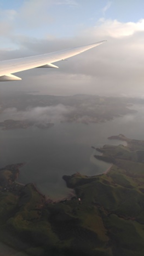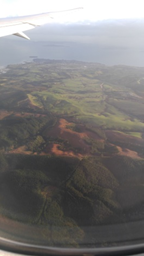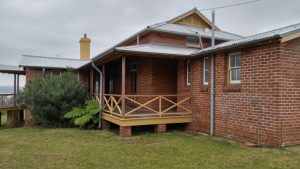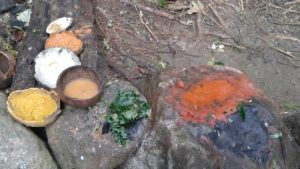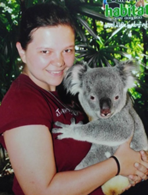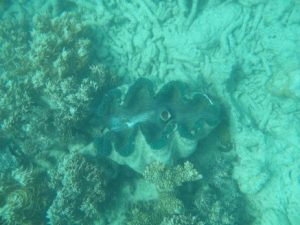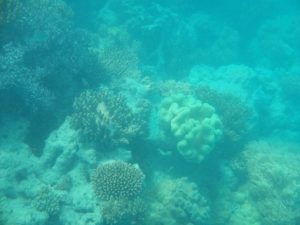STUDYING ABROAD IN AUSTRALIA
By: Mary Katherine Belknap
ABSTRACT
During my final summer in college, I came across an opportunity to travel to Australia in conjunction with my Capstone course. As a modified miniature study abroad, I spent two weeks engaging with a variety of Australian sites, history, people, and culture as part of interactive research for my open-topic senior thesis project. I gained insight into the diversities of this country through its people, its geography, and its history as I traveled through the cities of Sydney and Cairns. Because of the exposure to two unique and polar-opposite styles of cities, I gained significant exposure to Australian authenticates through its metropolitan and nature-based cultures. This article serves as an original written and photographed description of my experiences in Australia, and all that I was fortunate enough to learn in the process.
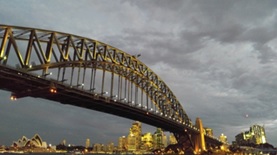 In the Summer of 2016, I attended a study abroad program to Australia through St. Edward’s University. Thought not a traditional semester-long or year-long experience, this program doubled as research in conjunction with my Capstone class that would be taken in the Fall 2016 semester. Along with about 20 other St. Edward’s students and three faculty members, I set out to establish a topic for my senior thesis while experiencing a country and continent I had yet to discover.
In the Summer of 2016, I attended a study abroad program to Australia through St. Edward’s University. Thought not a traditional semester-long or year-long experience, this program doubled as research in conjunction with my Capstone class that would be taken in the Fall 2016 semester. Along with about 20 other St. Edward’s students and three faculty members, I set out to establish a topic for my senior thesis while experiencing a country and continent I had yet to discover.
Before I even made it into Australia, I feared missing my trip entirely due to an airline issue from my extended flight from Los Angeles, California to Auckland, New Zealand. Stranded at the Auckland airport for a number of hours, I was unable to further my experience here while in the midst of trying to find additional flights and communicate with airport staff and my faculty advisers in Australia. However, I was mesmerized by the geographical view of New Zealand flying over it. The above pictures alone remind me of my desire to someday return to New Zealand to experience what it has to offer.
The first week of my two-week study abroad experience was spent in Sydney, Australia. Staying at a hostel in the historic Rocks District, I spent most of my days walking throughout the areas above. The hostel I stayed in served a dual purpose as both housing for incoming travelers and a museum displaying archaeological finds and historical information in The Rocks area I was staying at. I made my way around the Circular Quay (pronounced Circular Key) as I navigated my way up and down the coast and through much of the city’s nearby harbors. It was through this main port that I would utilize the ferry for a number of class-based meetings, tours, and personal exploration. I came to realize the significance of this mode of transportation as it serves an everyday need transporting people to and from their downtown jobs, school, activities, and even their homes. It also gave me time to contemplate all I was learning and observing as I made my way through evident merging remnants of Sydney as it transitioned from native homeland, to British convict territory, to a modern-day metropolis over the years. My time on the water allowed me to appreciate my experience at the given moment.
Even when in a foreign country for school-related research, there are some expected attractions that just have to be seen in person. The Sydney Opera House is one of Australia’s most iconic landmarks, so I had to make some time to tour it being nearly 20 minutes walking distance form my hostel. In addition to serving as one of the country’s most tourist-renowned establishments, the opera house stands as a World Heritage Area which is an area that is considered to be of cultural or physical significance by the United Nations Educational, Scientific, and Cultural Organization (UNESCO). It was built in 1957 by Danish architect Jørn Utzon as part of an international contest. It received its honors as a World Heritage Area in 1973 for its unique design and innovative construction while noting that the establishment houses a home for culture, theatre, and the arts. An outside view of the opera house can be seen in the photo on the left while one of its many theaters can be seen on the right. The opera house was where I was first exposed to the concept of a World Heritage Area. Prior to my visit in this country, I had never heard the term nor understood the significance of the organization and the honor behind this recognition. The opera house met the requirements for this title and continues to stand as a proud monument for Australia’s appreciation of the arts.
While in Sydney, I traveled outside the city limits to see some other very interesting sites. I finally got to partake in one opportunity that I desperately wished to do a number of years prior to that point in time: to walk through a rain forest. I was privileged to get a firsthand look at the wonders involved in a rain forest-based ecosystem.
Found in the town of Katoomba in New South Wales is the Jamison Valley, home to the Blue Mountains and its notorious Three Sisters. The valley is abundantly filled with Eucalyptus trees that emit natural chemicals and particles that create a relatively blue haze across the range. A blue hue is seen from a distance, resulting in causing the mountains to “turn blue” at certain points in the day. Despite a foggy day blocking a clear view of the Three Sisters, I was still able to get some shots of some of the mountain ranges and the rain forest itself.
This valley also houses an underlying rain forest with areas of the land sectioned off for research and professional use, and trails for visiting guests. In order to get into the valley, my class and I had to descend 310 meters at a 64 degree incline on the world’s steepest railway as seen above. The Jamison Valley is another one of Australia’s natural sites that made the World Heritage list for the revelation of a newly discovered plant species.
Back in the years of Pangaea when the worlds’ continents existed as one cohesive landmass, the land was categorized as being part of Laurasia or Gondwana. Experts and tour guides I met stated that this valley encompasses many of the prehistoric features as it was a piece of the Gondwana area. Knowing this, scientists understood the importance of preservation and research of this area. Through continuous research scientists stumbled upon a plant species dated back to prehistoric times that was thought to have been extinct for millions of years called the Wollemi Pine. Rediscovering fauna such as this produced a number of conclusions: 1) conservation of natural areas is crucial to scientific research, discovery, and modern benefits; 2) an area’s environment can hold roots to the past; and 3) this discovery earned the valley World Heritage status and is said to be one of the most significant botanical discoveries of our time.
The 2.4 kilometers of Jurassic forest I walked through was the first ever rain forest I was able to experience firsthand. I was elated to hear of this area’s scientific history and just as excited to hear about Aboriginal connection to this land as much of the faith and customs relates to nature and the human experience with the surrounding environment. One of the Aboriginal Dreamtime stories surrounding the Three Sisters explains the origin of its name. The Three Sisters are a range of three mountain peaks that stand overlooking the valley’s deep-running rain forest. According to legend there were three sisters residing in this Katoomba village who were not allowed to marry. When three male admirers in a nearby village plotted to capture the sisters in an attempt to marry them, a war was started between the two villages. A wise elder in the sisters’ village used his powers as a wizard to turn the sisters into stone for safety until the end of the war. However, the wizard was killed during the war and was unable to retract the spell he cast. To this day, the sisters stand as stone to forever stand watch over their village, while legend says that the spirit of the wizard lies in the manifestation of the Lyre Bird that flies throughout the valley.
This picture shows another history-laden location. This is the coast of Q Station formerly known as Sydney’s Quarantine Station. This view is a similar sight many new arrivals would be watching years ago. This location is part of the Sydney Harbour National Park and has now been renovated and restored for hotel, museum, and tour purposes.
This site was created as a quarantine station and an in-between stop for people immigrating to Australia between the 1830s and shutting down as recently as 1984. In an attempt to treat foreigners of possible diseases they may bring into to country, this establishment included a number of miniature stations that processed passengers upon their arrival. My class and I were given a private tour of the area and I was able to learn so much about immigrant-life in past Australia.
The entrance wharf brought in boats full of passengers as it does to tour-takers today. Staff had a check-in station and procedure to help the beginning stages of processing passengers. Because this time period heavily concerned itself with social status, this part of the process often separated people into groups whether they traveled as affluent first class, moderate middle class, or poorer lower class. From there, your status determined what kind of, if any, access to luxury you had through processing – such as being treated with more courtesy or respect or whether one was processed immediately as opposed to waiting days. One’s sense of worth and relevance was also an issue to cope with amongst class as many of these immigrants were of diverse cultures, many of which were treated with significantly less respect in the past.
The disinfectant station allowed for people to shower and partake in other similar chemical treatments to rid their bodies of disease and disease carriers. Passengers were escorted to metal shower stalls that contained just enough space for a vertical body to fit, told to strip off their clothing, and were instructed how to properly wash themselves while Q Station staff members ordered the instructions and watched passengers shower through peepholes in the metal walls to ensure correct cleaning procedure.
The boiler house was used for disinfecting of travelers’ belongings as they were just as susceptible to carrying disease as the passengers were. Large autoclaves that are still present onsite were packed full of luggage and personal items to be cleansed through a steaming process. Whether or not the passengers’ belongings survived the high temperatures was not assured until after the process.
A few additional buildings were left for housing and inhalation chambers. Dozens of people would be squeezed into tight rooms made of brick and cement as passengers made their way through the sterilizing process. Part of this time included very rustic breathing treatments where passengers were locked inside and forced to inhale chemicals the staff set off in the room. Despite their efforts to rid the passengers’ systems from internal toxins, it was later discovered that the chemicals used often had adverse effects causing more illness if not additional discomfort to the newly settled inhabitants.
If one was deemed ill or experiencing severe ailments during travel they were to walk to the hospital a solid couple of miles up a hill as the hospital had to been significantly distant from the masses below to avoid disease spread. The hospital was still often limited when it came to resources but housed a number of patients’ rooms, examination rooms, rustic doctor labs, and a cemetery within walking distance of the main hospital complex. If anything was admired by the patients living there, it was the view overlooking the cliff into the harbor.
The grounds gave a very ominous vibe as if one could understand the feelings of a space that once had such high levels of activity only to be suddenly abandoned with questions remaining of its past inhabitants. Numerous remnants from previous passengers are scattered throughout the area such as writings and graffiti in the picture seen above. Many immigrants wanted to find ways of documenting their experience here and much of the etched in art served as reminders of the lives passing through this area.
After my week in Sydney, it was onward and upwards to the city of Cairns (pronounced “Cans”). This is a significantly less bustling city in comparison to Sydney. Because of the city’s humid climate and very green and open landscape, this city is home to a great portion of Australia’s crucial environmental locations and unique biodiversity. Though riddled with some cityscape, much of my time and activities in Cairns involved me being outdoors.
One of the first opportunities I got to partake in while in Cairns was a Dreamtime walk through Mossman Gorge in the Fort Douglas area just outside Cairns. As previously mentioned, Aboriginal culture is the name of Australia’s native people, similarly compared to the United States’ Native American peoples. Dreamtime is the belief system from which all Aboriginal understandings of the world derive. Aboriginal culture is heavily nature-based which is commonly explained the “Dreamtime stories” that they use and etymology of the world and its creation as well as their motivation for living their lifestyle. They give much credit to the planet and all it offers and aim to use the earth’s resources with the utmost sense of reverence. Few descendants of this unique culture still exist today, and even fewer that thrive in modern day society choose to practice their traditional customs. Knowing that, it is a true privilege to be able to hear from current tribal descendants who still learn, practice, and teach their traditional customs and heritage.
Because much of Aboriginal culture is literally and figuratively rooted in nature, this Dreamtime walk took my class and I through a trail in Mossman Gorge filled with stops and artifacts that were explained by our Aboriginal guide Cameron. Coming from the Kuku Yalanji tribe, Cameron gave us insight to his and his family’s beliefs and practices that he was taught growing up. He explained the significance of his people and his heritage, and the deeply ingrained spiritual connection they have with the natural world around them. For example, the walk began with a smoke ceremony as a sign of respect to the earth and to Cameron’s ancestors – making them aware that he was bringing foreign guests into the forest under positive pretenses. Respect is a huge component of this culture and giving thanks to and asking permission from the earth or its resources is key to showing reverence.
Cameron’s ancestors and their livelihood had strong ties to the area and he explained to the class how we could visibly see this in nature. For example, the bowls of paint above are a part of traditional Aboriginal dot painting and are created from natural resources. The paint is made from water, colored rocks, and plant pigmentation: all resources found in their immediate surroundings. The paint is then used for body art and identification using strategic placement and colors to define the tribe one would be from. This became a type of insignia amongst the tribes and also allowed tribe members to understand who they belonged to, where their land was, and how far it extended as to not encroach upon another tribe’s rightful land. There was a significant sense of respect and responsibility amongst the tribe members I met, each one of them reminding me of the importance of honoring their ancestors and the land by using their resources respectfully when granted permission through prayer and “never taking from the earth more than you need.” It was also explained not only what each tribe had “granted permission” to use and be involved in, but how this also relayed in the lives of individual tribe members. For example, according to their culture, each individual has a number of totems that they are expected to respect throughout the remainder of their lifetime as they act as a type of guardian over those particular entities on earth. Another guide explained that one of his totems is a Cassowary bird; therefore, he will never kill or consume a cassowary bird and will instead do his best to honor and preserve that animal in multiple ways. He stands today as a traditional aboriginal dot painting artist, with much of his work representing the veneration of his totem: the cassowary.
My class and I traveled a little further away in the interior of the Daintree Rainforest. This rain forest is said to be one of, if not the oldest, in existence and is part of the greater Wet Tropics of Queensland, which is also a World Heritage Area. In its persistence in remaining an active relic of the Gondwana era rain forests, this area receives WHA status because much of Australia’s flora and fauna not only reside in this area but are also endemic to the Wet Tropics, meaning that they are native to or restricted to the Wet Tropics themselves. Because much of the nature here is relatively exclusive to the Wet Tropics, it is crucial to maintain the longevity of the rain forest’s lifespan or risk losing this biodiversity to extinction.
The gravity of this subject spoke significantly to me as I had been engrossed by the social justice behind environmental issues during my prior years at St. Edward’s. Being able to study about rainforest ecosystems in textbooks, classes, and even amongst intellectual discussion only speaks so much in comparison to walking the grounds one is studying about. Needless to say, I was ecstatic to continue my time in Daintree when I realized that my class and I would be able to stay in Daintree overnight and help participate in volunteer service for it the next day!
My class and I spent the night in small cabins run by a sustainable organization with much of their business procedures and profits going back into support for the rainforest. Thanks to the owners of this establishment and my class guide/driver Rick, we were educated on a number of the nonprofits and additional efforts currently in place to aid Australian rainforests. One of these was the Daintree Rainforest Observatory which is an organization connected with James Cook University. They are described as an eco-monitoring site working as an extension of the University’s efforts to research and preserve the rainforest. Much of their operations are continued by professors, students, and volunteers who live on site in exchange for their work.
My class spent half the next day not only learning about the establishment and its goals, but gaining the chance to work in their onsite revegetation station. We worked in a field of land designed to regrow rainforest fauna to compensate for the number of years of negative human impact and degradation to Daintree. I volunteered my time here by measuring tree diameter, height, color/livelihood, and leaf herbivory, or how much of the plant has been eaten by animals signified by holes in the leaves. Daily-to-weekly measurements of these statistics are vital to the Observatory because it details these plants’ relationship growing into existing rainforest land and it shows the results of what processes are and are not working in rejuvenating rainforest re-growth.
While getting to work in the rainforest, I also came across a number of more “typically Australian” wildlife. Some animals, such as the beautifully colorful cassowaries, were seen in the wild which are very unusual because of their massive decline in numbers. Other animals we got to see more closely at an interactive rehabilitation center where sick and/ or injured wildlife such as kangaroos and wallabies and Rainbow Lorikeets can be treated and then released back into the wildlife. Despite the controversial assumptions often brought about with this organization allowing so much public interaction with the animals, they follow strict laws that create a healing environment for the animals but do not infringe upon their well-being or safety. For example, my classmates and I did get the chance to hold a real koala but that koala’s “working hours” last only 30 minutes with limited holdings per person as too much of this stresses the koala. This center makes the animals’ progress their highest priority as that is the long-term goal and reason for the organization’s existence.
Despite not coming from a faith-based system rooted in Aboriginal custom or the like, that inescapable sense of respect I had constantly been told of while here overwhelmed me the longer I remained in the rainforest. It is an amazing natural system that has endless facets of fascination with every bit of information I absorbed when I was there. I almost thought I had reached my capacity after being so involved in all this nature-scape, but I had only seen some of the earth’s wonders on land. Now, it was time to go below sea-level.
I write about this final experience in Australia beginning with the Aboriginal creation story of this magnificent site. Many years ago, in the days of Dreamtime, there were only people and flatland as plants, animals, and diverse ecosystems did not yet exist. One day there came a serpent, often referred to as the rainbow serpent for its wondrous multicolored exterior. In search of its tribe, the serpent continuously slithered north up the eastern coast of Australia. As he traveled, the serpent created hills, mountains, and valleys making indentations for rivers and high-grounds along the land. When it reached north Australia, it found its tribe recognizing the language spoken amongst the residing humans. As he set up his tent for the night, two men seeking shelter were welcomed by the serpent as he offered residence in his mouth with no deceitful or malicious intent. The serpent left the area fearing the tribe would punish him for the missing men. Recognizing the men’s absence, the tribe decided to cut open the serpent revealing that the men had been turned into Rainbow Lorikeet birds. In anguish the serpent began destroying some of the mountains he made, and the tribe dispersed to escape the erosion only to start forming into plants and animals in the process. The serpent decided to leave and further avoid this situation by residing in the water off the coast of northeastern Australia. It is said that the serpent lived in the water until he died, and it is his remains and skeleton that created what currently stands as the colorful Great Barrier Reef.
The last couple days of my study abroad experience was spent exploring the one and only Great Barrier Reef. It is one of the world’s most unique underwater ecosystems, comprising of living coral systems and islands extending over 2,300 kilometers long across the northeastern coast of Australia.
The Reef, being the largest living entity on earth, is renowned for its colorful corals and its wide variety of exotic inhabitants. This was a major highlight of my study abroad experience because it felt exhilarating to be able to have such a connection with nature during my time there. Spending two days at the Reef (one day at the Inner Reef closer to mainland shore and one day at the Outer Reef in more open ocean) required some preparation that I had not done prior to any other excursion in Australia. My class and I took two days out of our week in Cairns to partake in classes from a certified organization in the city devoted to greater Great Barrier Reef education. Expert divers gave presentations, passed out physical learning materials and guidebooks (some of which seen above), and provided us with extensive safety knowledge to help us navigate the do’s and don’ts of interacting within the Reef. My class even sat in on a lecture at James Cook University detailing a number of venomous wildlife, much of which included species residing in the Reef. My professor wanted the class to be over-prepared so that we all may enjoy the experience and so that we may be able to focus on another volunteer and research opportunity. While at the Reef, my class and I conducted a 360 degree survey of one reef section where we accounted for biodiversity presence; counted different species of fish, coral, additional marine life within 25 general categories; and measured water quality through sampling in conjunction with measuring physical species health for that section. These notes were returned to the boat staff present as these types of surveys are conducted to remain up to date on the Reef’s progress in an area the boat staff frequents.
This set of pictures come from my first day at the Inner Reef. The area behind me and extending further back is the stretch of land that my class and I kayaked and snorkeled for the day, getting to see some of the Reef structures that are closer to the mainland. The waters were rougher than expected for their winter months according to the staff guiding us. Because of this, it was difficult to document the experience with pictures. Thanks to my underwater camera I was able to capture some decent pictures of the unique coral structures and some of the wildlife such as the sea turtle swimming a few feet beneath me.
Once we took our day at the Outer Reef, I felt that my class and I gained a more significant appreciation of the Reef as we were able to see it and interact with it more clearly. The pictures above depict only some of the incredible things I saw as I swam the Reef. There were various colorful fish species that were easy to locate and some wildlife like clams that took a more focused eye to catch. Of course I will never be able to forget the stunning corals engulfing the area. The vibrant corals and their multicolored inhabitants created a gorgeous mosaic of underwater life in action; as if one were finally looking past stunning appearances of dramatically painted pictures and the graphics of Finding Nemo to see the intricacies of sea life centimeters away from one’s fingertips. I have never been snorkeling like this before, but I can attest to the fact that there is no other under water experience like swimming the Great Barrier Reef on my own.
Throughout this process, I was taught about many of the Reef’s benefits, many of its hidden dangers, and more importantly about its greater significance to Australia, Aboriginal culture, and to the world at large. Swimming the Reef and witnessing it first-hand was an incredible experience in its own right: to think, one of the most fascinating phenomena in the natural world was living right below my hands. I was proud to know that in all the activity and in the previous preparation there were a number of top-notch organizations involved in the Reef taking careful and sustainable practices to ensure its safety despite their human impact. With the one visual that saddened me in seeing some of the coral losing its pigment through climate changes visible effects of coral bleaching, I still felt pride in being amongst people who aim to treat the Reef with respect as they understood the importance of preserving it. It also inspired me to return home with a reignited passion for environmental sustainability in hopes that other natural wonders such as this may be positively impacted by my influence.
Traveling to Australia was an undeniably fantastic gift I was given during my time at St Edward’s University. The locations I visited, the people I encountered, the independence in finding my bearings in the city and in research, the ever-constant stimulation of all my senses during international travel; everything I was fortunate to experience gave me greater perspective and a more resounding respect for the life I am able to live and the world I am able to live in. To witness the history of a country that was so new to me and to see nature at its purest and interact with exotic animals in all the ways we did; it made me realize how much I love learning, how much I love expanding my knowledge to worldly limits, and how much I love the work I have done towards protecting my environment at home. The wonders of this experience were incredible as I was going to be able to contribute to the resolution of environmental social issues that are so deeply embedded in my heart. Although much of this was devised for a simple Capstone course, this study abroad experience treated me with incomprehensible amounts of understanding and memories that will last me a lifetime.
AUTHOR BIO
 My name is Mary Katherine Belknap and I am a former student of St. Edward’s University. I am 22 years old and graduated with a Bachelor’s degree in Business Administration in December 2016. My time at St. Edward’s was enhanced by my inclusion in a number of student-oriented organizations, on-and-off campus volunteerism, and global experience in traveling to India, the United Arab Emirates, Peru, Jamaica and Australia through university-sanctioned programs. I was heavily influenced by this global engagement as well as through work with social justice issues, primarily of the realm of the natural world and environmental sustainability. Due to these topics’ significant impact, I move forward pursuing professional goals by merging my business degree, environmental interests, and care for social justice. As I further define these goals, I open myself to knowledge and experiences with which information I can apply to bettering my community in all the work I perform.
My name is Mary Katherine Belknap and I am a former student of St. Edward’s University. I am 22 years old and graduated with a Bachelor’s degree in Business Administration in December 2016. My time at St. Edward’s was enhanced by my inclusion in a number of student-oriented organizations, on-and-off campus volunteerism, and global experience in traveling to India, the United Arab Emirates, Peru, Jamaica and Australia through university-sanctioned programs. I was heavily influenced by this global engagement as well as through work with social justice issues, primarily of the realm of the natural world and environmental sustainability. Due to these topics’ significant impact, I move forward pursuing professional goals by merging my business degree, environmental interests, and care for social justice. As I further define these goals, I open myself to knowledge and experiences with which information I can apply to bettering my community in all the work I perform.

